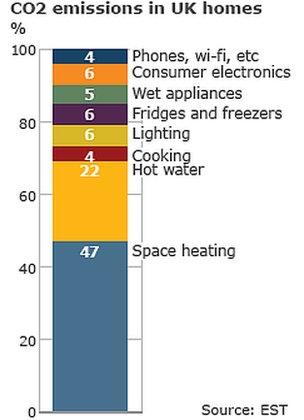'Energy House' to reveal scale of UK retrofit challenge
- Published
The 'energy house', a typical terrace home built inside a laboratory in Salford
A unique study, involving a full-scale terraced house built inside a chamber, hopes to find ways the UK housing sector can cut its energy use.
The University of Salford project will assess how energy efficiency technology performs in a range of conditions.
Researchers say homes account for 25% of emissions, which needs to be tackled if the UK is to meet its target of cutting emissions by 80% by 2050.
The Energy House was officially opened by Climate Change Minister Greg Barker.

Researchers will be able to control heat, light and humidity levels inside the chamber, allowing the team to subject the Energy House to a range of "weather" conditions, such as freezing temperatures, rain and snow.
Erik Bichard, one of the researchers involved in the three-year project, says that 70% of houses that will be standing in 2050 have already been built, so it is vital to understand what energy savings can be made by "retrofitting" technologies to existing homes.
"In policy terms, there are some quite stark facts," Professor Bichard told BBC News.
"More than 90% of our houses don't meet the recommendations for insulation and energy efficient devices, such as boilers and washing machines.
"If our houses are going to be around for a long time and they are very leaky in heat terms, the next question is how do we move forward and quickly," he observed.
"Policymakers are struggling because 70% of the UK's housing stock is in private ownership, and a further 10% is owned by private landlords.
"To influence all of those individuals is a tall order. We need to make things cheaper, easier and more effective in order to make people to want to invest their money in this."
'Pay as you save'
The coalition government hopes to tackle the problem through its Green Deal Scheme, which will allow homeowners from 2012 to approach their energy supplier for a loan to cover the cost of insulation, instead of paying in advance.
Instead, in an ideal situation, they would repay the loan using the savings made on their energy bills.
Climate Change Minister Greg Barker told BBC News that the data gathered from the Energy House experiments would be "absolutely key" for the scheme.
"The 'pay as you save' model that underpins the Green Deal relies on fitting and installing measures that pay for themselves," he explained.
"So in order for people to be sure when they fit certain measures that they will pay for themselves, we need robust testing and monitoring - the sort of thing that will be done at the University of Salford."
Mr Barker added that he was confident that the coalition's Green Deal could deliver the energy savings needed in people's homes to ensure that the UK was on track to meet the target of cutting emissions by 80% from 1990 levels by 2050.
Paul King, chief executive of the UK Green Building Council, said: "The biggest barrier to cutting carbon emissions from our existing housing stock has been the high upfront cost of refurbishment, so government has done the right thing by making its 'Green Deal' such a flagship policy.
"However, there is a real danger that high interest rates on a typical Green Deal 'package' will put people off and will limit the number of energy efficiency measures available to the householder.
"Unless we keep the cost of finance low, for example by using the new Green Investment Bank, we'll miss this golden opportunity to cut carbon, cut energy bills and create new green jobs."
- Published16 November 2010
- Published23 August 2010
- Published9 December 2010
- Published16 June 2010